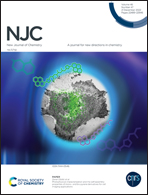A novel tetrathiafulvalene based liquid crystalline organogelator: synthesis, self-assembly properties and potential utilization†
Abstract
Supramolecular gels and liquid crystals are two important organic soft materials in self-assembly systems. A series of new low-molecular-weight organic gels was synthesized by connecting two cholesterol molecules and two hydrophobic chains incorporating amide groups to a central tetrathiafulvalene (TTF) moiety (1a–l). Compounds 1a–l and their corresponding charge transfer complexes easily formed a stable supramolecular gel in various organic solvents and their self-assembly morphologies and structures were investigated. It was revealed that hydrogen bonding and van der Waals interaction played important roles in the gelation process. More importantly, nearly half of the gelators exhibited liquid crystalline phases of type smectic A in a particular temperature region; there was no crystallization but there was vitrifying to form glassy mesogens during cooling from the isotropic melt. The effects of the linker chain length and terminal alkoxy chain on liquid crystals were studied. The liquid crystalline organogelator with TTF unit was first designed and synthesized. It was demonstrated that the gelators obtained from cyclohexane had a strong ability to adsorb the toxic dye Rhodamine B from water. This property of this series of compounds is considered to have potential utilization for the removal of toxic dye molecules from wastewater.



 Please wait while we load your content...
Please wait while we load your content...